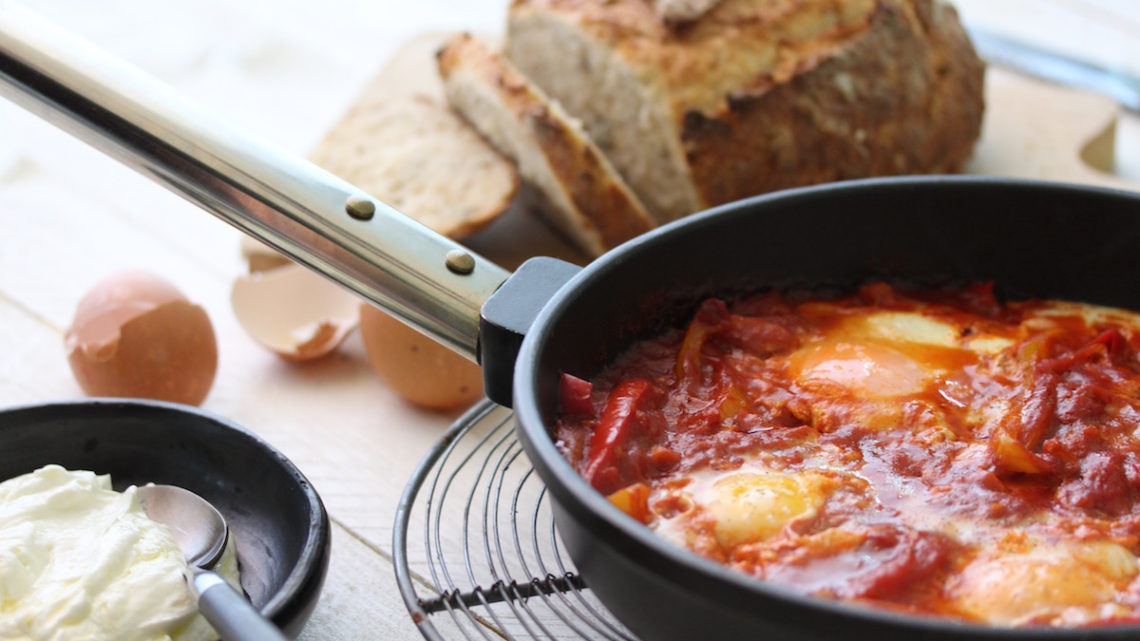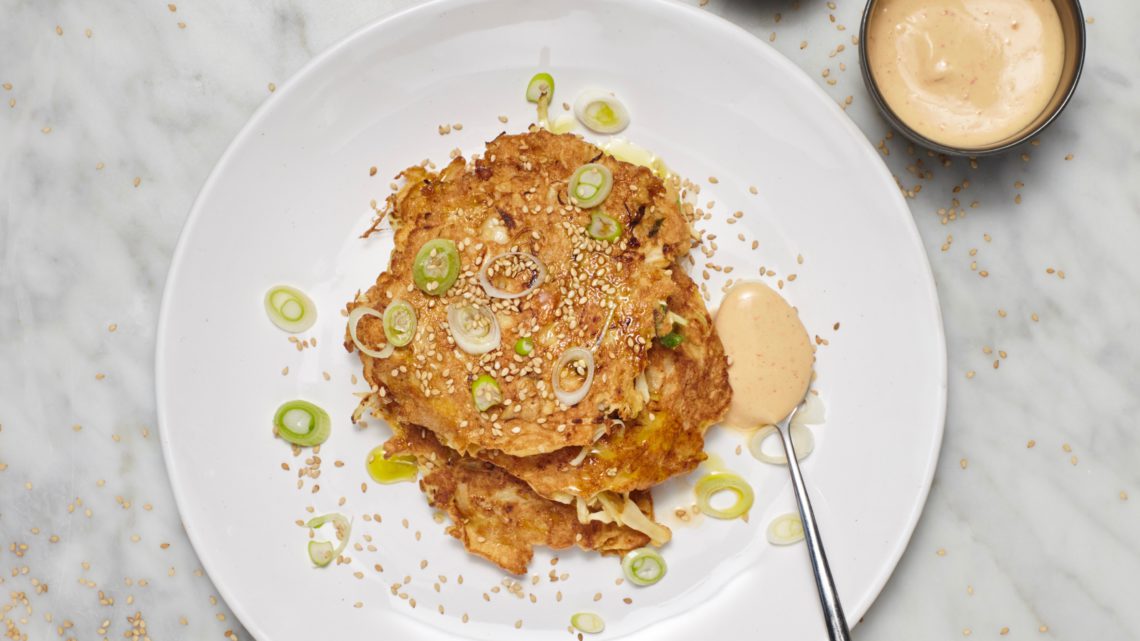Shakshuka
One of our favourite vegetarian dishes to come from the Middle East, Shakshuka is dish of eggs poached in a pepper and tomato stew. To spice things up a bit, we add a little harissa.
Serves 4
Ingredients
6 tablespoons olive oil
salt
pepper
1-2 tablespoons harissa
1 tin tomato puree
2 red peppers
2 yellow peppers
2 onions
3 cloves garlic
2 tins peeled tomatoes
1/2 teaspoon ground cumin
8 eggs
1 small tub Greek yoghurt
Method
1
Slice the peppers and onions into thin strips and finely chop the garlic.
2
Heat a frying pan over medium heat with 3 tablespoons olive oil. Fry the peppers for about 10 minutes, adding the garlic for the last minute. Add the harissa, the tin tomato puree and the cumin to the pan and fry for a further 10 minutes.
3
Add the tin of tomatoes, salt, pepper and 200 ml water to the pan. Bring to a boil and simmer gently for 15-20 minutes.
4
Make 8 ‘wells’ in the sauce. Gently crack the eggs into the wells. Place a lid over the pan and cook over medium heat for about 8-10 minutes until the egg whites have set and the yolks are still soft. Swirl the egg white through the sauce using a fork so that it sets quicker, if you wish. Season with salt and pepper.
5
Place the Greek yoghurt in small bowl and drizzle with 2 tablespoons olive oil.
6
Divide the sauce and eggs between 4 plates. Serve with the Greek yoghurt.
Delicious served with fresh bread or pita.
Coconut Lime Chicken with Rice
An easy and healthy dish which is light and full of zingy flavours. A satisfying weekday recipe.
Serves 2
Ingredients
150g jasmine rice
400 g chicken thighs, boned
2 baby gem lettuce
1 small tin coconut milk
2 limes
15 g mint
1 red chilli pepper
olive oil (3 tablespoons)
salt
pepper
fish sauce
Method
1
Preheat the oven to 200° C. Bring a pan of salted water to the boil. Add the rice and cook for 10 minutes. Drain the rice off through a sieve; add a small amount of water to the pan. Set the sieve over the pan, cover with a lid and allow the rice to steam over a low heat.
2
Finely chop the red chilli. Place the chicken in a bowl, drizzle over 2 tablespoons olive oil, season with salt and pepper, squeeze over the juice from the lime and add half he chopped chilli. Heat a grill pan over high heat and grill the chicken thighs on both sides. Place the chicken in a roasting dish and roast in the oven for 20 minutes.
3
Finely chop the mint. In a bowl, mix together 120 ml coconut milk, the juice of half the second lime, fish sauce to taste, the chopped mint and remaining chopped chilli. Click the leaves off the baby gem lettuce.
4
Lay the baby gem leaves in a serving bowl. Spoon the rice on top. Slice the chicken diagonally into pieces and place on top of the rice. Spoon over the coconut dressing and serve.
Okinomiyaki
Okonomiyaki is a Japanse snack of egg-rich pancakes filled with savoury ingredients such as shrimp, cabbage and spring onions. The pancakes are paired with a super-easy and delicious dipping sauce made with Japanse mayonnaise, soy sauce and hot sauce.
Serves 2
Ingredients
4 eggs
2 teaspoons container sesame oil
1-2 teaspoons chilli sauce
300g shredded cabbage
3 spring onions
150g pink shrimp
10g container sesame seeds
3 tablespoons sunflower oil (3 tablespoons)
1/2 cup Japanese or regular mayonnaise (½ cup)
soy sauce (2 teaspoons for the sauce and about 2 tablespoons for the batter)
20g flour (20 g)
salt
pepper
Method
1
Preheat an oven to 200° C. Coarsley chop the shrimp and finely slice the spring onions.
2
Mix ½ cup mayonnaise with 2 teaspoons soy sauce and chilli sauce to taste. This is the dipping sauce.
3
Whisk the eggs in a bowl with 20 g flour and add the shredded cabbage, prawns, spring onion, sesame oil and soy sauce to taste. Mix all the ingredients together well.
4
Heat a frying pan over medium heat with 2 tablespoons sunflower oil. Add spoonfuls of the batter to the pan just as you would for American pancakes. Fry for about 3 minutes on each side. Lay them on an oven tray lined with baking paper. Heat them up in a preheated oven fora bout 3 minutes.
5
Divide the pancakes between 2 plates, sprinkle over the sesame seeds and serve with the dipping sauce.
Home made granola
Granola is so easy to make and the best thing is you can put in ingredients you like. Here's our recipe, but feel free to play around with your own flavours.
Makes about 1kg
Ingredients
500g oats
100g hazelnuts, coarsley chopped
100g almonds, coarsley chopped
50g cashews
100g pecan nuts, coarsley chopped
25g sesame
25g sunflower seeds
25g pumpkin seeds
125g golden syrup
100g maple syrup
a good sprinkle of cinnamon
60g dried cranberries
60g raisins
60g dried apricots, roughly chopped.
60g prunes
Method
Preheat an oven to 160 C.
Mix all the ingredients together, except for the dried fruit and divide between to oven trays which have been lined with baking paper. Bake in the oven for about 30 minutes or until everything becomes evenly golden coloured. Give it a mix every 10 minutes or so.
Remove from the oven, allow to cool and mix in the dried fruit. Store in an airtight container.
Delicious served over yoghurt with fresh or stewed fruit.
Blood Orange Marmalade
This is a recipe we have adapted from Delia Smith.
Makes about 6 x 350 ml jars
Ingredients
900 g blood oranges
1 lemon
1.8 kg granulated sugar
Method
Begin by measuring 2.25 litres water into a preserving pan, then cut the lemon and oranges in half and squeeze the juice out of them. Add the juice to the water and place the pips and any bits of pith that cling to the squeezer on a square of muslin.
Now cut the orange peel into quarters with a sharp knife, and then cut each quarter into thinnish shreds. As you cut, add the shreds to the water and any pips or spare pith you come across should go on to the muslin. The pith contains a lot of pectin so don't discard any and don't worry about any pith and skin that clings to the shreds – it all gets dissolved in the boiling.
Now tie the pips and pith up loosely in the muslin to form a little bag, and tie this on to the handle of the pan so that the bag is suspended in the water. Then bring the liquid up to simmering point and simmer gently, uncovered, for 2 hours or until the peel is completely soft (test a piece carefully by pressing it between your finger and thumb).
Meanwhile, chill a couple of saucers in the freezer.
Next, remove the bag of pips and leave it to cool on a saucer. Then pour the sugar into the pan and stir it now and then over a low heat, until all the crystals have dissolved (check this carefully, it's important). Now increase the heat to very high and squeeze the bag of pips over the pan to extract all of the sticky, jelly-like substance that contains the pectin. As you squeeze you'll see it ooze out. You can do this by placing the bag between two saucers or using your hands. Then stir or whisk it into the rest.
As soon as the mixture reaches a really fast boil, start timing. Then after 15 minutes spoon a little of the marmalade on to one of the cold saucers from the freezer and let it cool back in the fridge. You can tell – when it has cooled – if you have a 'set' by pushing the mixture with your little finger: if it has a really crinkly skin, it is set. If not, continue to boil the marmalade and give it the same test at about 10-minute intervals until it does set.
After that remove the pan from the heat (if there's a lot of scum, most of it can be dispersed by stirring in half a teaspoon of butter, and the rest can be spooned off). Leave the marmalade to settle for 20 minutes.
In the meantime, the jars should be washed, dried and heated in a moderate oven for 5 minutes. Pour the marmalade, with the aid of a funnel or a ladle, into the jars and seal while still hot.
Label when cold and store in a dry, cool, dark place.
We, the Amsterdam Flavours chefs, hope you enjoy this recipe as much as we do. If you have any questions on how to prepare it or just want to send us your feedback, you can reach us here Contact Amsterdam Flavours





